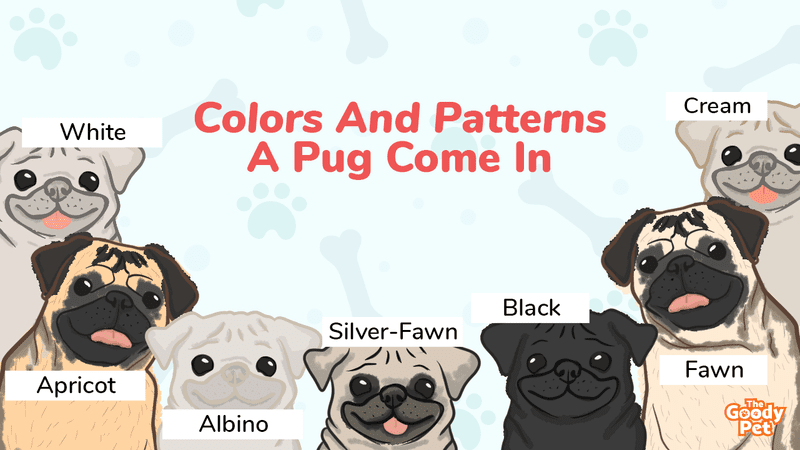It’s finally official that I’m bringing home a Pug to my young family. Before reaching this decision, I’ve been doing my research about these short snout furry friends and discovered plenty of facts, including the diverse array of coat colors and patterns that they adorn.
Black and fawn are the two official Pug colors recognized by the AKC. But you can find your Pug in a few other uncommon colors and patterns such as the Panda, Sable, and Brindle.
You might be interested to know that the FCI and the UK and Canadian kennel clubs recognize a few more Pug colors including Silver and Apricot. Read about all the other interesting details on Pug coat colors and patterns in the rest of the article.
16. Merle
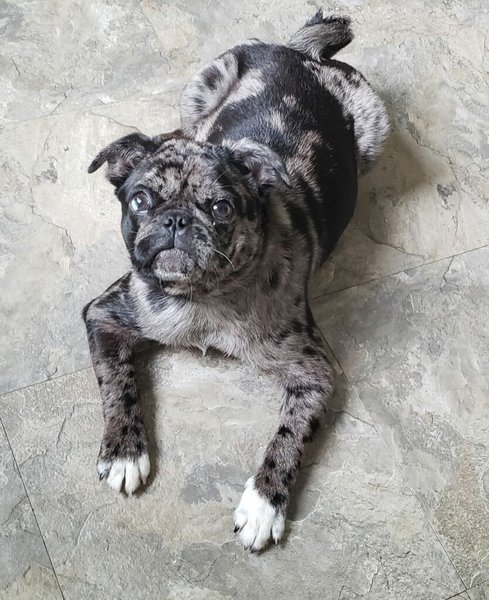
Merle coats in dogs are a result of the dominant merle allele in the M-locus (M) which randomly dilutes sections of solid black dog coats to a lighter color (usually gray but sometimes white). Variations of the merle are defined by heterozygosity (a pair of Merle and non-merle, Mm) and homozygosity (a pair of two merles, MM).
Like other merle dogs, merle Pugs have irregular patches of diluted skin pigment against a background of solid black patches as well as blue eyes.
15. Brindle
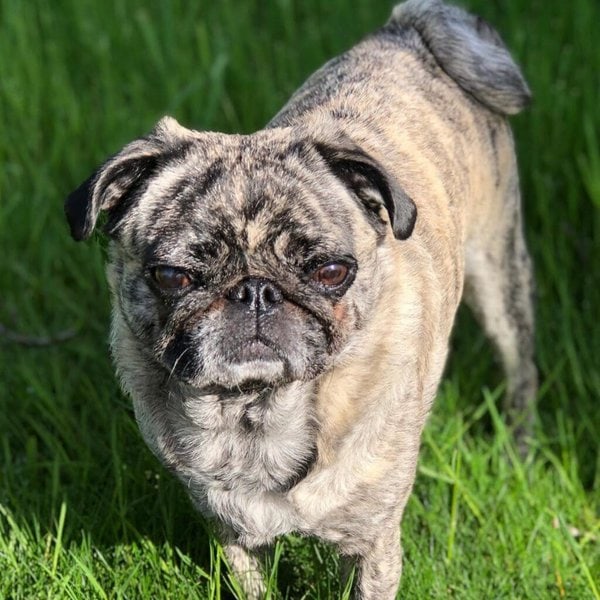
Brindle is another of the rare coat patterns in Pugs that is caused by a recessive K locus allele. A brindle Pug receives a pair of the brindle allele from each parent.
The typical presentation of the brindle pattern is black stripes against shades of red as seen on the brindle Pug image above. But the background color may vary depending on gene interaction and present other colors such as tan, silver, liver, and even blue.
14. Black And Fawn Sable
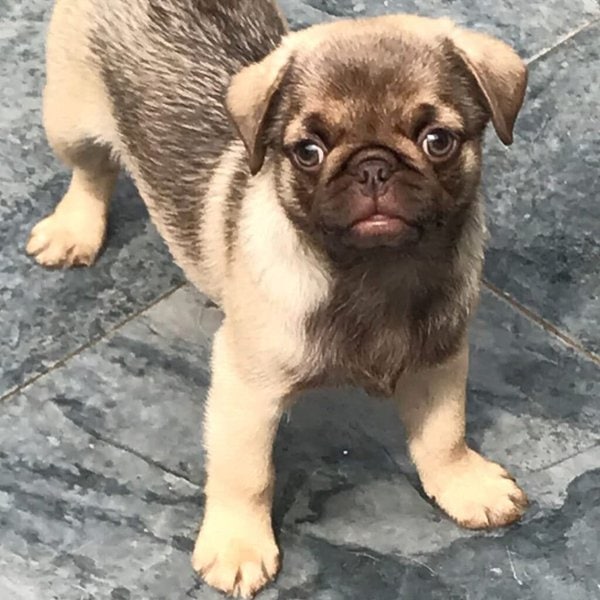
The complex black & fawn sable Pug coat results from the equally complex interaction between the agouti gene, the MC1R gene, and the K Locus (dominant black) and recessive black genes.
This interaction between genes can restrict the agouti expression resulting in rare Pug coats like the black and fawn sable which carries the recessive black gene.
As a difference with the sable, black & fawn sable has darker patterns of black especially on the back, even while manifesting the black-tipped hairs on a fawn background.
13. Apricot Sable

The Sable color in dogs is a coat pattern resulting from one of the four alleles in the agouti gene. Sable dog coats present in black-tipped hairs on a base of silver, gray, tan, or yellow.
Sable Pugs have black-tipped hairs on a fawn base. The sable pattern is distributed throughout the Pug’s body and may appear darker on the back and lighter on the chest.
The eyes, nose, muzzle, and ears retain the usual dark color as most Pugs.
12. Panda (Black And white)
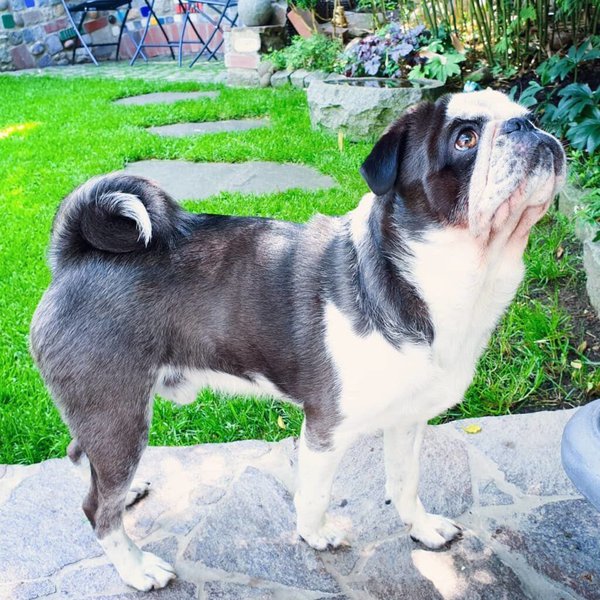
The panda or black & white Pug is among the coat colors labeled ‘trendy’ or ‘exotic.’ It is just as rare as other nonofficial Pug colors.
A panda Pug can have more white or more black color on their coat. They also have a black patch around the eye, just like the panda.
Breeders will often label panda Pugs as unique and sell them for a higher price, just as happens with other rare Pug colors, including the albino.
11. Silver Fawn

Silver fawn is a variant of the fawn and is often categorized as a fawn. This coat color is an official Pug color for the Canadian kennel club.
The silver-fawn color presents in shades that could range from a light/deep apricot or reddish-gold with a fading shiny-gray sheen.
As with the silver color, silver fawn Pugs are often described and registered as a fawn. They are also a rather rare variant of the Pug’s common fawn coat.
10. Silver

The silver coat is a rare variant in Pugs. Though not listed as an official Pug color by the AKC it has the official Pug color status for the FCI and the UK kennel club.
You will notice a Silver Pug by its grayish-dark shiny color. But, because they are not black, some owners will describe the silver Pugs as a fawn and some kennel clubs will register them as such or as an alternate color.
9. Brown
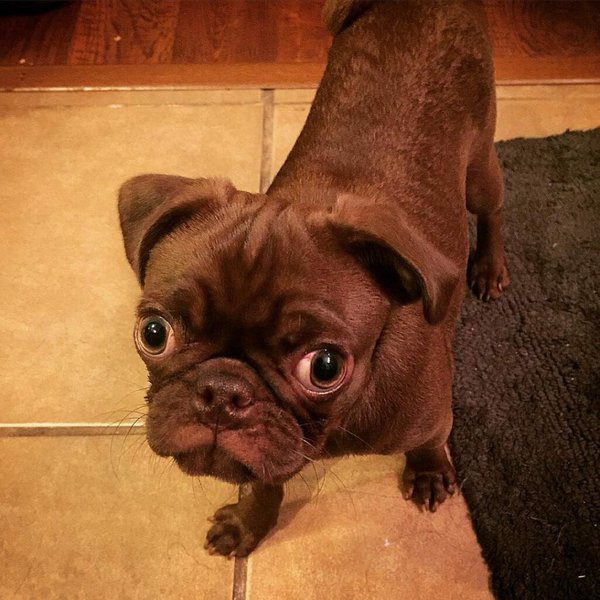
In the science of dog coats, the brown color is caused by the brown (B) locus which is also responsible for the chocolate and liver colors. The B locus can have a dominant (B) allele or a recessive (b) allele. A pair of bb alleles dilutes the basic black pigment to cause a brown coat.
The brown Pug coat is hard to come by. But when it does, it manifests in a solid brown color throughout the Pug’s body, including the area around the nose, eyes, and muzzle.
8. Black & Tan
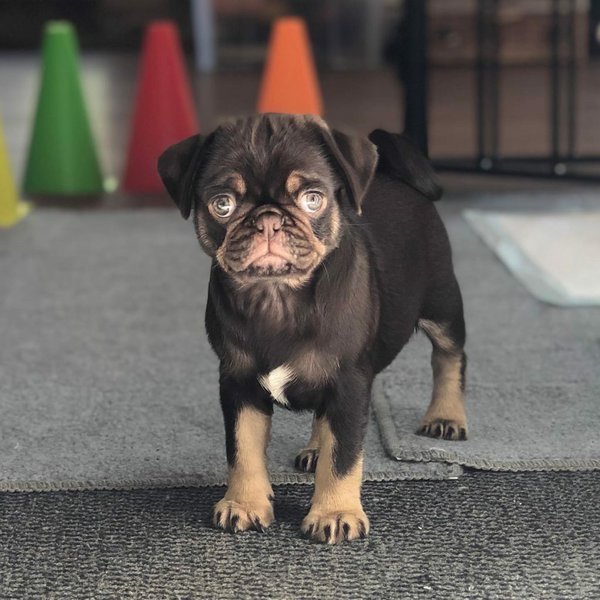
Black & tan is another of the rare coat color combinations in Pugs. Black and tan Pugs have a majorly black coat on most of their body with tan patterns on the tail, ears, head, chest, and legs. A distinctive pair of tan spots may appear over the eyes.
To differentiate the black & tan Pug from the black & cream variant, notice the darker tan that tends towards a chocolate/brown rather than the pale cream.
7. Black & Cream
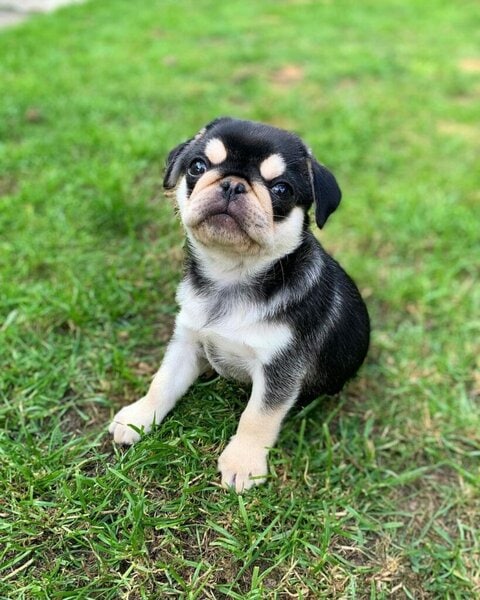
Black & cream is one of the common bicolor coats in many dog breeds, but not necessarily common in Pugs.
The black & cream Pug comes with a combination of black as the main coat color with cream markings on the face, legs, ears, chest, and around the neck. It is differentiated from the black & tan Pug by the paler cream markings.
Black & cream is not considered purebred, and thus not an official Pug color.
6. White
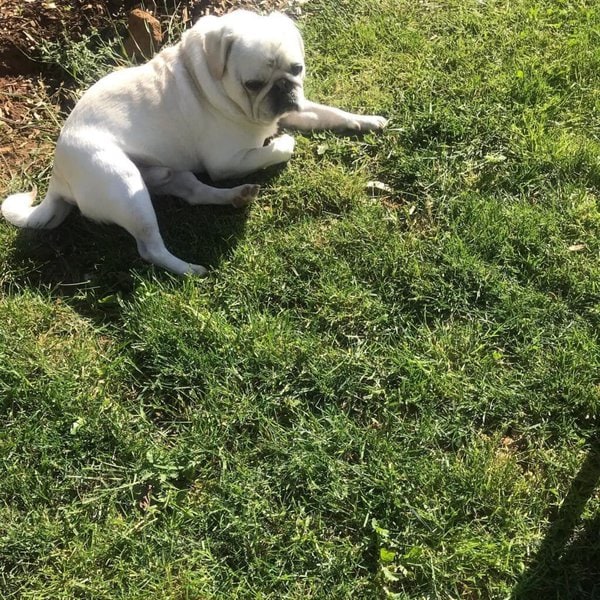
The all-white Pug is among the rarest coat colors of the Pug. It should not be confused with the albino, which may resemble the white in fur color but lacks the black pigmentation on the nose and eyes.
Like all other unofficial Pug colors, white Pugs are not considered purebred and will not be allowed on the show ring, even if they are registered by a kennel club.
Given the Pug’s playful nature, you will most likely need to groom your white pug more often than you would one with darker colors.
5. Albino
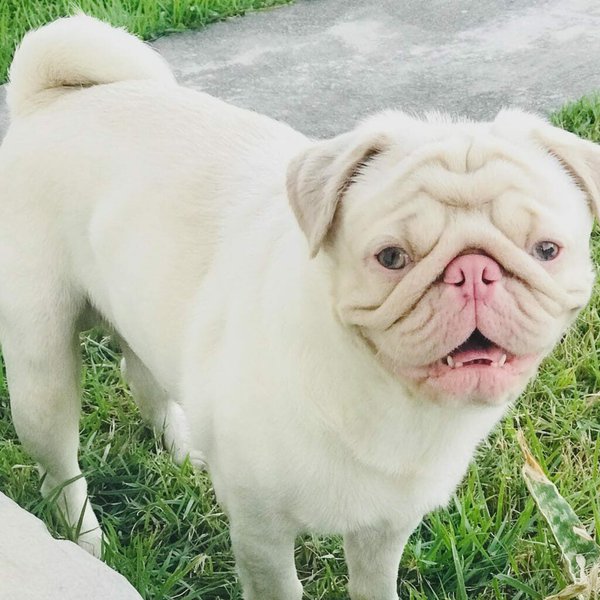
Albinism is generally rare in dogs. It results from the absence of the genes that produce melanin, the pigment responsible for skin and fur color. Dogs with two copies of recessive genes are more predisposed to both albinism and other health issues.
An albino Pug lacks skin pigment, what most people describe as pink eyes and nose. They don’t manifest the usual black color around the eyes and noses as other Pugs and their eyes are usually blue, though some may have translucent eyes.
4. Cream
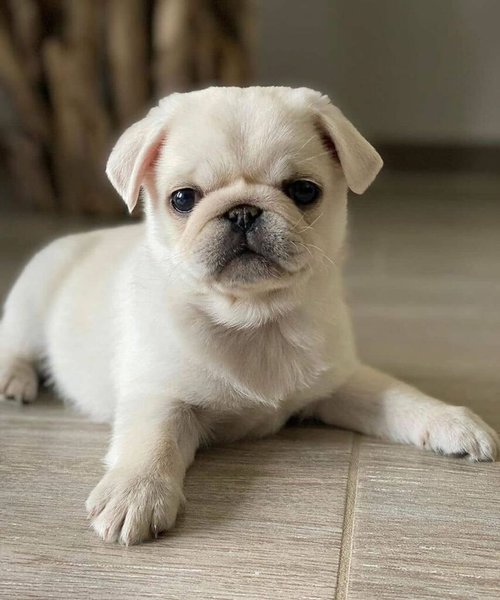
A cream dog coat color is neither fawn nor white. Cream Pugs carry this pale color throughout their body. But they have little or more of the black color around their eyes, ears, and muzzle, which is a differentiating feature between the cream and the albino Pug.
Because the cream color tends towards the fawn or white, cream Pug owners often categorize them as fawn white. But cream Pugs lack the yellowish-tan of the fawn and the sheen of a pure white Pug.
3. Apricot
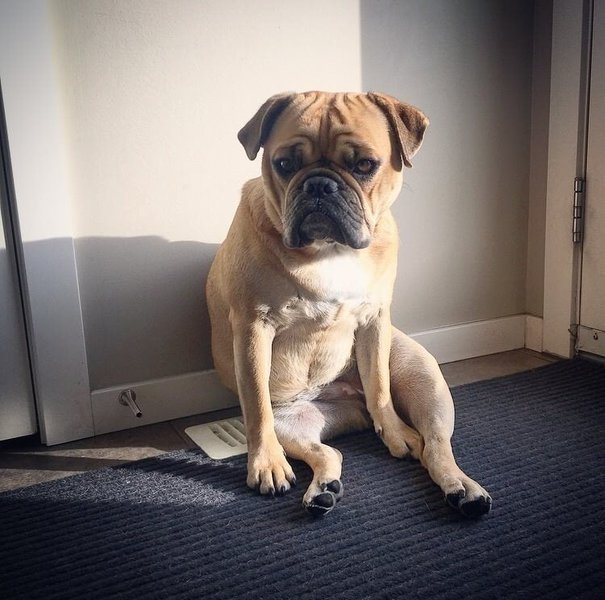
Apricot Pugs have a light-yellowish/orange color similar but paler than that of the apricot fruit. The color is especially dense on the Pug’s back and head but could be a bit lighter on the chest and legs.
Even though not an official color of the AKC, the UK kennel club lists apricot among its 4 official colors of the Pug together with silver, fawn, and black. Apricot is also the third most common Pug color after fawn and black.
2. Fawn
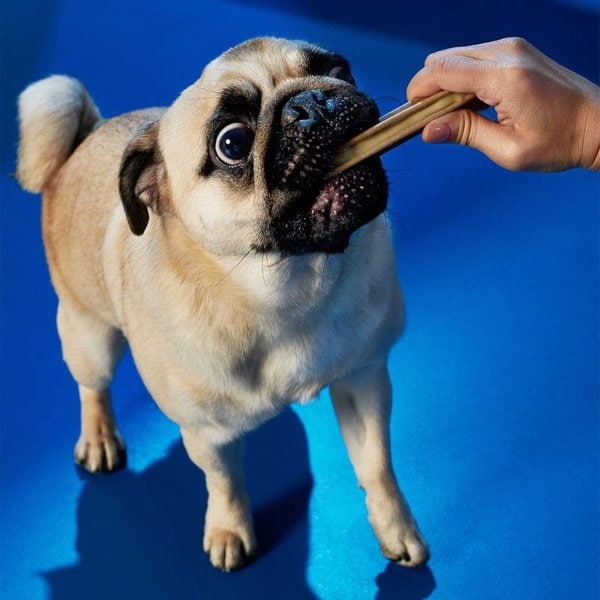
The info that the majority of Pugs are fawn is not a myth. According to PetPugDog’s GIANT Book of Pug Care, 65% of Pug owners in the US, UK, Australia, and Canada who answered the survey question “What color is your Pug?” had a fawn Pug. Also, 63.1% of Pugs in the UK are fawn according to a 2016 study.
Fawn Pugs will have a light yellowish-tan but can also tend towards shades of pale-tan or dark dear-red. The American, UK, and Canadian kennel clubs as well as the FCI recognize fawn as an official Pug color.
1. Black

Black is the second most common coat color in Pugs. Of the 1,009 Pugs involved in a UK study, 27.7% had black coats, second only to fawn. It is one of the official colors of purebred Pugs recognized by the AKC and other national kennel clubs.
Black Pugs have a solid color throughout their body, giving their smooth, soft, and short coat a glossy look. Black also distinguishes most of the other Pugs by the markings around the eyes, nose, and muzzle, except for the albino and brown color.
Related Questions
What Is The Rarest Pug Color? There’s no single Pug color that can be said to be the rarest. Instead, unofficial colors such as brown, cream, white, albino, silver as well as the panda, black & cream, black & tan, and silver fawn combinations are rare. The sable, black & fawn sable, brindle, and merle are also rare Pug coat patterns.
How Do I Know If My Pug Is Purebred? Even though most of us assume that a dog with papers (registered by a kennel club) is a purebred dog that is not always the case. Instead, a more precise way of telling if your Pug is purebred is by taking an advanced dog DNA test that assesses your dog’s DNA profile to match it with the standard profile of the Pug breed rather than just the parents’ DNA.
What Color Pug Is Better? If a dog’s color has anything to do with grooming, then darker pug colors may be easier to groom. Dust and dirt are harder to spot on black fur and this retains the aesthetics of the pug for a longer period of time as compared to one with a lighter fur color. Besides, it is said that most black Pugs have a single coat and shed less than double coat Pugs. But color does not define a Pug’s temperament unless it is indicative of a health problem such as albinism. Hence, Pug owners will consider a Pug’s color better purely on personal preference.

